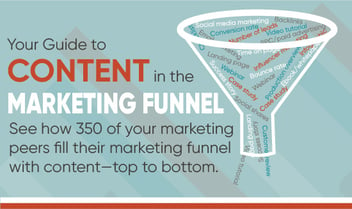5 Types Of Business Blog Readers: Which Are You Reaching?
.jpg)
We’ve said that it is important to write blog posts for readers. (See here.) But that brings up a key question: Who are your readers? And who do you want to have as readers?
Of course, you want to write blog posts and other marketing content that appeals to each of your customer personas, especially if you have a variety of services or products or if you serve niche markets in multiple industries. But this isn’t just about personas. This is about the level of interaction your readers have, and how to attract and keep the readers that matter the most.
Let’s split readers up into 5 categories, and talk about the benefits of reaching each category, how to appeal to that category, and how to help move readers along from one to the next.
1. Blog Visitors
Much of your blog traffic will come from visitors — those who are just visiting your site for the first time after coming across it in an online search, or perhaps who click through to your posts from social media from time to time, but aren’t really involved or committed.
These visitors, even if they never convert on an offer or become a subscriber, play a role in your blog’s SEO by sending important signals to search engines about the quality of your content. Make sure they are sending the right signals by providing content that encourages readers to stick around and to visit other pages on your site.
Tips for doing that:
-
Make sure your headline or social media links are an accurate reflection of what readers will find — you don’t want them to immediately bounce because the headline seemed to promise one thing, but the blog post delivered something different.
-
Offer internal links to related content, whether that is other blog posts, landing pages for relevant offers, your services and/or product listings or the “about” page.
Keeping these first-time and casual readers on your site longer, and encouraging them to visit more pages improves SEO to give you a greater chance of generating even more traffic.
2. Blog Subscribers
Subscribers have provided their email address and asked for regular updates because they believe your blog offers value. Like other visitors, their interaction with your site is an important signal for search engines, so keep giving them the problem-solving, educational, inspirational or entertaining content that will keep them coming back.
While they may not have (yet) accessed an online offer, you are building a relationship with subscribers based on trust and consistency. And they can also become ambassadors for your blog and your company, even if they aren’t necessarily a fit as a customer themselves. After all, 94 percent of people who share blog posts do so because they think they will be helpful for other people. (Source)
Appeal to them by continuing to provide useful content, delivered on the schedule they choose, and you may be able to leverage their loyalty into exposure to new audiences.
Or, they may be a fit as a customer, but just not seeking your solution at this time. Perhaps later, as they continue to learn about you, they will end up transitioning to the next category on our list.
3. Contacts
Once a visitor or subscriber converts on one of your offers — a free trial, downloadable asset, or other online offer — they become a lead or a contact because they have given you their contact information, along with permission to contact them (unless otherwise indicated on the landing page form).
Because of their conversion, you have an idea of what interests them, what problems they may be trying to solve, and whether you have a solution that could fit them.
As soon as a visitor converts into a lead, you should have an automated response in place that sends an immediate welcome message and also enters them into an automated lead nurturing workflow to provide additional content based on what offer they accessed. (Why lead nurturing? Here are 10 reasons.)
Generating leads — as opposed to simply website traffic — is the most important objective for inbound marketers, as seen in the State of Inbound 2017 Report detailing marketers’ goals, tactics, challenges and future plans. Leads are a step closer to customers, and by definition are prospects for whom you have at least a minimal amount of information — their email or other contact info, what they have accessed on your website, and sometimes even company name, job title and other details.
Turning blog visitors and subscribers into leads requires thinking beyond the solutions you provide in the blog post itself to the additional offers you can link to that will appeal to those readers. Gated behind a landing page, these offers can range from ebooks and templates to webinars, free trials, calculators and case studies. (Need ideas? 25 Offers to Appeal to Every Stage of the Buying Cycle)
4. Hot Leads
Not all leads are equal, as you know. Some of those who download offers on your website may be competitors scouting out your content, or students preparing for a class project, or someone in a related industry looking for tips, but not actually a fit for your company’s products or services.
But some leads keep coming back. By using closed loop marketing, you can track your leads’ actions on your website, monitoring which blog posts they read and which offers they download, giving you a picture of where they may be in a decision-making process.
As you analyze your lead nurturing over time, you will be able to pinpoint certain actions that indicate a lead is ready to be turned over to sales for more personal contact. Those actions might be reading certain blog posts that are written from a “bottom-of-the-funnel” perspective, such as posts on choosing a vendor for your product or service. Or the trigger could be downloading a specific type of content, such as a product comparison or pricing sheet.
Use these kinds of triggers to set your definition for a marketing-qualified lead and set your automation software to identify these “hot leads” for transition.
Of course, this relies on having content available — both blog posts and additional case studies or sales-related materials — that address the needs of “hot leads”. (What Inbound Leads Need to See In The Decision Stage)
5. Customers
Finally, if you are writing your blog correctly, it will likely still appeal to your customers as well. Why keep writing for the folks who have already signed on the dotted line? Because you want them to become your brand ambassadors, who share your content with others because they think it is useful and they are happy with the service they receive.
Word-of-mouth, along with online sharing, are still key ways of attracting customers and leads, and your own current satisfied customers can play an important role in letting others know about all you have to offer.
Continue to write blog posts for your customers, as well as newcomers. Blog posts for customers might include tips on getting the most out of your solution or using existing products in new ways. And send your current customers information about other content that they may want to share with others. Sometimes it pays off to ask them directly to share.
You can also get your current customers involved in your blog by featuring them, with Q&A posts, case studies or congratulations on achievements.
So, who are you writing your blog posts for? Casual visitors, subscribers, contacts, hot leads or customers? The answer should be “all of the above.” All of them play a role in improving your blog’s ability to attract visitors, convert them into leads and nurture them into customers.
Find more about creating a great business blog — and the mistakes you’ll want to avoid along the way — in Business Blogging: Do This, Not That, one of the 2018 additions to our Inbound Marketing Learning Library.
-1.png?width=1652&height=294&name=Jones(RGB)-1.png)











